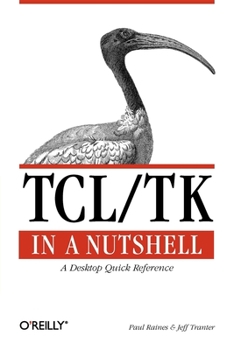Tcl/Tk in A Nutshell
Select Format
Select Condition 
Book Overview
The Tcl language and Tk graphical toolkit are simple and powerful building blocks for custom applications. The Tcl/Tk combination is increasingly popular because it lets you produce sophisticated graphical interfaces with a few easy commands, develop and change scripts quickly, and conveniently tie together existing utilities or programming libraries. One of the attractive features of Tcl/Tk is the wide variety of commands, many offering a wealth of options. Most of the things you'd like to do have been anticipated by the language's creator, John Ousterhout, or one of the developers of Tcl/Tk's many powerful extensions. Thus, you'll find that a command or option probably exists to provide just what you need. And that's why it's valuable to have a quick reference that briefly describes every command and option in the core Tcl/Tk distribution as well as the most popular extensions. Keep this book on your desk as you write scripts, and you'll be able to find almost instantly the particular option you need. Most chapters consist of alphabetical listings. Since Tk and mega-widget packages break down commands by widget, the chapters on these topics are organized by widget along with a section of core commands where appropriate. Contents include: Core Tcl and Tk commands and Tk widgets C interface (prototypes) Expect incr Tcl] and incr Tk] Tix TclX BLT Oratcl, SybTcl, and Tclodbc
Format:Paperback
Language:English
ISBN:1565924339
ISBN13:9781565924338
Release Date:May 1999
Publisher:O'Reilly Media
Length:454 Pages
Weight:1.40 lbs.
Dimensions:0.9" x 6.0" x 9.0"
Customer Reviews
3 ratings
Good reference, not so good for beginners
Published by Thriftbooks.com User , 20 years ago
If you need some hand-holding and are just getting started with TCL then this book is not for you. Tcl/TK in a nutshell is exactly what the title says, a desktop quick reference. Don't expect many examples or explanations. Compared to Perl / C style languages TCL is a little weird to look at and takes some getting used to. And it's easy to get tripped up if you aren't already experienced with the language. A lot of the material in the book doesn't go any deeper than the TCL man pages. So beginners, get a different book / tutorial to learn the language. If you are proficient in TCL than this book would make a great reference, but as a beginner (to TCL, not to programming) a lot of times I had to supplement what the book gave by searching the web for examples to making things clearer. But it is definitely useful for looking up rarely used / obscure commands that you may have forgotten. Even though the book lacks a lot of examples and hand holding it is very comprehensive and covers a lot of material.
It's not a tutorial....
Published by Thriftbooks.com User , 22 years ago
The previous reviewers seemed to think that this book would teach them the way of TCL/TK and were thoroughly disappointed. But what they failed to realize that this book is meant to be nothing more then a reference book. Perhaps if they had paid attention to the product description, they would have been prepared.A thing to keep in mind, anytime an O'Reilly book has "...in a Nutshell" after the title... it's a reference book. Pure and simple. Say it with me, people. R-E-F-E-R-E-N-C-E. Not to be confused with "Master TCL/TK in 24 hours" or what have you.So, keeping that in mind, as a reference book, it does a fantastic job as the rest have stated. Makes for a good "dictionary" so to speak.
As usual, a great book from O'Reilly.
Published by Thriftbooks.com User , 25 years ago
An excellent reference for Tcl, Tk, the C interfaces, Expect, [IncrTcl/Tk], Tix, TclX, BLT, OraTcl, SybTcl, & TclOdbc. Sure it doesn't cover everything that everyone will use, but that's not really possible.My only real complaint has to do with the books formatting. For most commands, the formatting is fine, but for commands with subcommands (such as string), the subcommands are unnecessarily hard to read. With that one exception, this is my favorite Tcl Book.






